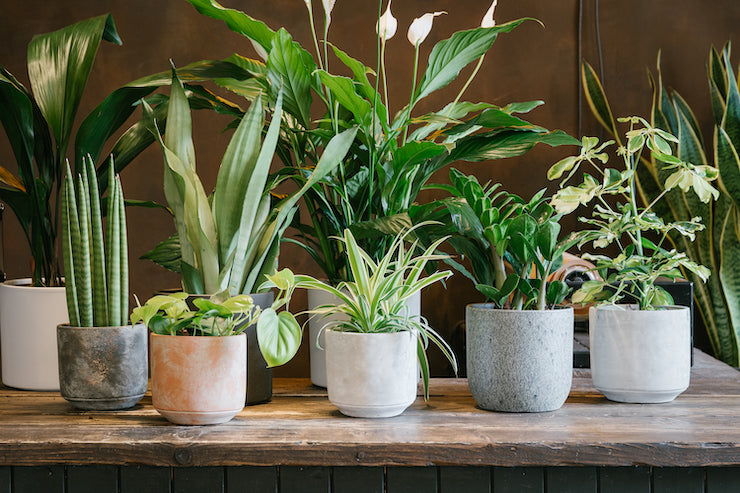
The Weird and Wonderful World of Orchids
Did you know that orchids are one of the largest species of plant in the world with thousands of different varieties? They are so adaptable that they can be found all over the world in tropical rainforests and even desserts!
There are two main types of Orchid. The most recognisable are Epiphytic Orchids with impressive, long-lasting blooms. The lesser known are Terrestrial Orchids which are a smaller variety of orchid that grow close to the ground.
Phalaenopsis
Phalaenopsis are epiphytic as they anchor their root systems to the barky surface of the trees high up in the rainforest canopy. These orchids are more readily available here in the UK and their blooms are prized for their incredible range of colours and patterns.
These orchids are naturally protected from direct light beneath the leaves of the rainforest canopy and will thrive in the bright, in-direct light in our homes. You’ll notice that this type of orchid comes in a clear plastic pot, this is because they photosynthesise through their roots. A good amount of water is also stored within their roots. For this reason, the soil should be allowed to almost dry out completely before rewatering. A great indicator of when your orchid is ready for a drink is when their roots turn from green to silver. We would also suggest that you frequently mist the leaves and roots. Phalaenopsis like to be rootbound and require repotting every twelve to eighteen months into a clear pot. Bark based repotting mixes, such as Orchid Focus are important for this stage as they replicate the bark textures of their natural habitat. Due to their epiphytic nature, these orchids have adapted to surviving on low levels of nutrients and require light feeding, using Focus Orchid Grow Feed or Orchid Bloom Feed, every second watering in the Spring and Summer. It is best to avoid leaving your orchids to sit in a cold draught and also not to repot when the plant is in bloom. For a complete orchid repotting kit why not try our Orchid Myst Repotting Kit?
Orchid flowers can last for as long as five months at a time. Their blooms dying back is often confused with the death of the plant! However, this is not the case. If the leaves are still sturdy and green, then the plant has simply reached the point in its life cycle when their flowers die back. For epiphytic orchids you can either wait for the stem to turn woody and cut at the base of the plant or, whilst the stem is still green, cut above the second or third node. It is important to use clean, sharp scissors to avoid any cross contamination of bacteria between plants. New stems can grow from the old stem node and the orchid will flower again in around two to three months. For more tips and tricks check out the Growing Orchids at Home: The Beginners Guide for an authoritative and detailed guide by orchid experts.
Terrestrial Orchids
The Ludisia discolor and Macodes petola are terrestrial orchids and also known commonly as Jewel Orchids. Their natural habitat is the tropical forest floor where they thrive in decomposing leaves which have fallen from the rainforest canopy.
There are many types of terrestrial orchids with differing care. Below we have chosen the three most commonly found types.
Ludisia discolor Care
Ludisia discolor are the most common variety of Jewel Orchid, known for their deep purple leaves with striking red veins. They can produce tall stems adorned with clusters of delicate white flowers. Position in bright, in-direct light to light shade and allow the top two inches of compost to dry out completely before rewatering. This could be every 1 – 2 weeks, but always stick your finger into the compost to ensure it is sufficiently dry. Water sparingly in winter to avoid root rot. Mist the leaves frequently. Repot in a general indoor plant compost such as Houseplant Focus mixed with Better Grow Perlite. Feed every two to four weeks in spring and summer. Ideally feed with a tomato feed which is higher in potassium than a general houseplant feed. However, a general houseplant can also be used and we recommend Liquid Gold Leaf.
During dormancy in the autumn and winter reduce watering and allow the plant to remain rootbound until spring.
Macodes petola and Anoectochilus siamensis Care
The sought-after Macodes petola is identified by the incredible sparkling veins that run through their deep green leaves. The Anoectochilus siamensis is another rare terrestrial orchid that is prized for its snakeskin-like appearance. Although vastly different in their patterns these special plants are a treasured option for terrarium lovers and have identical care.
Native to the rainforests of Thailand these beauties thrive in warm and humid environments. These conditions can be replicated in the UK when placed in moderate to bright, in-direct light. If kept in a particularly warm spot keep the soil moist. Alternatively allow the top centimetre to dry out before rewatering. When saturating the compost gently raise the lower leaves of the Macodes to avoid water sitting on any parts of the plant. If you notice any moisture is left on the leaf, use a paper towel to gently pat it dry. This will prevent rot. Where possible, these plants prefer distilled water.
These varieties do particularly well in closed terrariums as they can be left to grow in a humid environment without too much water sitting on their leaves from heavy misting. If you do not have a terrarium to add, simply place an upturned jar over the plant or place a pebble tray underneath to create prime levels of humidity. When planted in Sphagnum Moss consider repotting these Jewel Orchids every 8-10 months to reduce the risk of root rot. Alternatively, create a potting mix using 20% soil.ninja Fine Bark, 50% soil.ninja Sphagnum Moss and 30% Better Grow Perlite. This will create a less dense mix and allow for more airflow around the roots.
We hope you enjoyed our Orchid Care Blog - discover more orchids on our website. For those seeking something very unusual, look out for the sought-after Anoectochilus roxburghii x Ludisia discolor, a rarely seen Jewel Orchid hybrid!



